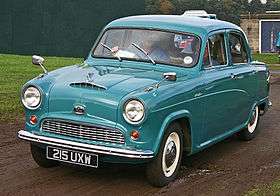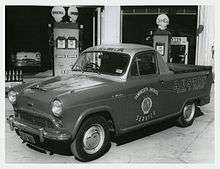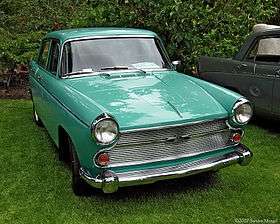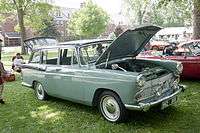Austin Cambridge
| Austin Cambridge | |
|---|---|
| Overview | |
| Manufacturer | Austin Motor Company |
| Production | 1954–1971 |
| Assembly | Cowley, Oxford, England |
| Body and chassis | |
| Class |
Small family car (1954 - 1958) Large family car (1959 - 1969) |
| Body style |
4-door estate 4-door saloon 2-door van 2-door coupé utility (pickup)[1] |
| Layout | FR layout |
| Chronology | |
| Predecessor | Austin A40 Somerset |
| Successor | Austin 1800 |
- See Austin 10 for the Cambridge models of 1937 to 1947.
- See Austin A40 for other A40 models.
The Austin Cambridge (sold as A40, A50, A55, and A60) is a motor car range produced by the Austin Motor Company, in several generations, from September 1954 through to 1969 as cars and to 1971 as light commercials. It replaced the A40 Somerset and was entirely new, with modern unibody construction. The range had two basic body styles with the A40, A50, and early A55 using a traditional rounded shape and later A55 Mark IIs and A60s using Pininfarina styling.
Note that the A40 number was re-used on a smaller car (the Austin A40 Farina) from 1958 to 1967, and that the Cambridge name had previously been used to designate one of the available body styles on the pre-war 10 hp range.
Initially the Austin Cambridge was only offered with a 4-passenger, 4-door saloon body, although a few pre-production 2-door models were also made. It had a modern body design with integrated wings and a full-width grille. Independent suspension was provided at the front by coil springs and wishbones but a live axle with anti-roll bar was retained at the rear.
A van derivative introduced in November 1956 and a coupé utility (pick up) introduced in May 1957 and remained available until 1974, some 3 years after the demise of the cars on which they had been based.
A40 Cambridge
| A40 | |
|---|---|
 Austin A40 Cambridge | |
| Overview | |
| Production | 1954–1956 |
| Body and chassis | |
| Body style | 4-door saloon |
| Powertrain | |
| Engine |
1.2 L Straight-4 42 bhp[2] |
| Dimensions | |
| Wheelbase | 99.25 in (2,521 mm)[2] |
| Length | 162.25 in (4,121 mm) |
| Width | 61.5 in (1,562 mm) |
| Curb weight | 2,352 lb (1,067 kg) |
A 1.2 litre straight-4 pushrod engine B-Series engine based on the one used in the previous Austin Somerset (although sharing no parts) powered the new Austin Cambridge. A maximum power output of 42 bhp (31 kW) was claimed: power was transmitted to the wheels by means of a four-speed gear box controlled with a column-mounted lever.
The A40 Cambridge was intended to be available in both two door saloon and four door saloon variants however the two door body style did not reach production.[3]
Only 30,666 A40 Cambridge models were produced.[4] After the A40 Cambridge was dropped early in 1957, the A40 name was re-used on the smaller A40 Farina, though that car, the 'Countryman' version of which was an early example of a hatchback, was neither a replacement nor much related to the A40 Cambridge.


A50 Cambridge
| A50 | |
|---|---|
 | |
| Overview | |
| Also called | Austin A50 Coupe Utility[1] |
| Production | 1954–1957 |
| Assembly |
England Australia[5] Japan[6] |
| Body and chassis | |
| Body style |
4-door saloon 5-door estate (Japan)[7] 2-door coupé utility (Australia)[1] |
| Powertrain | |
| Engine |
1.5 L B-Series Straight-4 50 bhp[2] |
| Dimensions | |
| Wheelbase | 99.25 in (2,521 mm)[2] |
| Length | 162.25 in (4,121 mm)[8] |
| Width | 61.5 in (1,562 mm)[8] |
| Height | 61.5 in (1,562 mm)[8] |
| Curb weight | 2,352 lb (1,067 kg) |
Also introduced in September 1954, and with a body identical to that of the A40 Cambridge,[9] was the A50 Cambridge which used a new 1.5 litre (1489 cc) B-Series four-cylinder engine with single Zenith carburettor which was good for 50 hp (37 kW). It sold better and remained in production through to 1957 with 114,867 A50s being produced[4]
The de luxe version had a heater, leather seat facings, carpets replacing the standard rubber matting, armrests on the doors, twin-tone horns, a passenger sun visor, and some extra chrome including overriders.[8]
Technical advances in the A50 Cambridge included an optional Borg-Warner overdrive unit for the top three (of four) gears. A semi-automatic transmission (branded "manumatic" and providing pedal-free clutch operation) was also offered, but it was unpopular with buyers.
A number of modifications were introduced in October 1956 including smaller 13 in (330 mm) wheels and increased compression ratio (8.3:1).
A de luxe version tested by The Motor magazine in 1955 had a top speed of 73.6 mph (118.4 km/h) and could accelerate from 0–60 mph (97 km/h) in 28.8 seconds. A fuel consumption of 28.0 miles per imperial gallon (10.1 L/100 km; 23.3 mpg-US) was recorded. The test car cost £720 including taxes.[8]
A radio and a clock were optional extras.
As with its predecessor the A40 Somerset, the A50 Cambridge was built under licence by Nissan in Japan; the arrangement ended in 1959. In total, 20,855 licensed Austin vehicles were produced by Nissan in Japan.[10]
 Austin A50 Cambridge, side view |
 Austin A50 Coupe Utility (Australia) |
A55 Cambridge
| A55 | |
|---|---|
 | |
| Overview | |
| Also called | Austin Cambrian (North America)[11] |
| Production | 1957–1958 |
| Body and chassis | |
| Body style |
4-door saloon 2-door van 2-door coupe utility (Australia) |
| Powertrain | |
| Engine |
1.5 L B-Series Straight-4 51 bhp[2] |
| Dimensions | |
| Wheelbase | 99.25 in (2,521 mm)[2] |
| Length | 167 in (4,242 mm)[12] |
| Width | 61.5 in (1,562 mm)[12] |
| Height | 60 in (1,524 mm)[12] |
| Curb weight | 2,352 lb (1,067 kg) |
In January 1957, the A55 Cambridge was introduced to replace the A50 model. It used the same 1.5 litre B-Series engine as its predecessor, though with a higher compression ratio: 51 hp (38 kW) at 4250 rpm was now available.[12]
The Cambridge had been restyled somewhat and now had a larger boot and much larger rear window. The car was also lowered by fitting 13 in (330 mm) road wheels which were smaller than those on the A50 but the overall gearing remained the same by changing the rear axle ratio. Two tone paint was an option.
154,000 were produced when it was replaced by a new Pininfarina-designed A55 Cambridge for 1959.[4]
Van and pick-up versions based on the pre-"Farina" A55 were introduced in 1957, and remained in production until 1973.[13] From 1962 they were fitted with the 1622 cc engine and renamed A60, fitted with a wider grille never seen on the Cambridge car, and also offered under the Morris 1/2 ton name.[13] In their final years the van and pick-up were all designated "Morris", following a decision to remove the Austin badge from British Leyland commercial vehicles.
A de luxe A55 with manumatic transmission was tested by The Motor magazine in 1957 had a top speed of 77.1 mph (124.1 km/h) and could accelerate from 0-60 mph (97 km/h) in 27.0 seconds. A fuel consumption of 31.6 miles per imperial gallon (8.9 L/100 km; 26.3 mpg-US) was recorded. The test car cost £870 including taxes of £291.[12]
-

Austin A55 Cambridge in profile
-
Austin A55 Coupe Utility. The Pressed Metal Corporation of Sydney, Australia designed and assembled this coupe utility variant of the Austin A55 Cambridge.[1]
-
_panel_van%2C_2012_HCVS_Tyne-Tees_Run.jpg)
1971 Austin 1/2 Ton Van
-

Morris Half Ton Van
- ^ BMC-Leyland Australia Heritage Group, Building Cars in Australia, 2007, page 198
A55 Cambridge Mark II
| A55 MarkII | |
|---|---|
 Austin A55 Cambridge Mark II Saloon | |
| Overview | |
| Also called | Austin Cambrian (North America)[11] |
| Production | 1959–1961 |
| Body and chassis | |
| Related |
Morris Oxford Riley 4 MG Magnette III Wolseley 15/60 Siam di Tella Shamrock Aster |
| Powertrain | |
| Engine |
1.5 L B-Series Straight-4 55 bhp[2] |
| Dimensions | |
| Wheelbase | 99.25 in (2,521 mm)[2] |
| Length | 178.5 in (4,534 mm)[14] |
| Width | 63.5 in (1,613 mm)[14] |
| Height | 59.75 in (1,518 mm)[14] |
| Curb weight | 2,464 lb (1,118 kg) |
The A55 Cambridge Mark II, known as the first "Farina" model because of its Pininfarina design, was produced from 1959 through to 1961. It was a rebadged Morris Oxford and retained the 1.5 litre B-Series engine, now with an SU carburettor, and producing 55 bhp (41 kW) at 4350 rpm.
The interior had individual leather trimmed seats in front spaced closely together to allow a central passenger to be carried. The gear change was either on the column or floor-mounted and the handbrake lever between the driver's seat and the door. Other improvements highlighted at the time included an enlarged luggage compartment with counterbalanced lid and increased elbow width on both front and rear seats.[15] A heater could be fitted as an optional extra.
A "Countryman" estate model appeared in 1960. Austin Cambridge Estates were called "Countryman". (Morris Oxford Estates were called "Traveller".) A55 Mark II and A60 Estates were identical from the windscreen back; the later models never got the reduced rear fins and modified rear lights of the A60 saloons.
The engineering of the car was conventional with coil sprung independent front suspension and a live axle at the rear with semi elliptic leaf springs. The braking used a Girling system with 9 in (229 mm) drums all round.
149,994 were built in total.
A MkII A55 was tested by The Motor magazine in 1959 had a top speed of 75.5 mph (121.5 km/h) and could accelerate from 0–60 mph (97 km/h) in 24.5 seconds. A fuel consumption of 31.0 miles per imperial gallon (9.1 L/100 km; 25.8 mpg-US) was recorded. The test car cost £878 including taxes of £293.[14]
 Austin A55 Cambridge Mark II Saloon |
 Austin A55 Cambridge Mark II Estate |
Australian production
.jpg)
The A55 Mk II entered production in Australia in 1959 with a 1622 cc version of the "B" Series four-cylinder engine as the Austin A60.[16] Australian use of the larger engine and the A60 name thus preceded British usage by two years.[16] The A60 was replaced in 1962 by a revised model powered by a six-cylinder 2433 cc engine. It was marketed as the Austin Freeway and was produced by BMC Australia until 1965.[16]
A60 Cambridge
| A60 | |
|---|---|
 | |
| Overview | |
| Production | 1961–1969 |
| Body and chassis | |
| Related | Morris Oxford series VI |
| Powertrain | |
| Engine |
1.6 L B-Series Straight-4 61 bhp[2] petrol 1.5 L Straight-4 40 bhp[2] diesel |
| Transmission | 3-speed automatic |
| Dimensions | |
| Wheelbase | 100.3 in (2,548 mm)[2] |
| Length | 174.5 in (4,432 mm) |
| Width | 63.5 in (1,613 mm) |
| Height | 58.5 in (1,486 mm) |
| Curb weight | 2,464 lb (1,118 kg) |
An updated Cambridge model, now called the A60, was introduced for 1961. It included a new 1.6 litre version of the B-Series straight-4 engine which had first been used in the MGA. Modified styling included side chrome stripes – some models with contrasting colour infills – and reduced fins on the rear wings. The style continued to be known as "Farina". This body covered a chassis that was slightly longer in wheelbase and wider in track than the A55. This allowed three people to be accommodated on the rear seat. Anti-roll bars were added to both front and rear suspension.
A diesel version was introduced in 1961 for export cars and was available in the UK from 1962. Early manual models had the option of column gear change. The Borg Warner three-speed Type 35 automatic transmission was an option, the first British car to be fitted with this type,[17] with the selector on the steering column.
The A60 Cambridge sold well, with 276,534 being built before production finally ended in 1969. Its intended successor, the front-wheel-drive Austin 1800 of 1964, did not dent sales, so Cambridge production was continued until 1969 at the Morris plant at Cowley when the Austin Maxi took over production and the Morris Oxford version continued in production until 1971, when the Morris Marina was launched.
Austin A60 saloons assembled in Ireland by Brittain Smith of Portobello, Dublin 2 were identifiable by the use of Morris Oxford series VI tail-lights. The last of these were produced in 1970, and some were registered in 1971. The A60 Cambridge was effectively replaced by the Austin Maxi hatchback in April 1969, while the Oxford continued until early 1971, when it was replaced by the Morris Marina.
The car was popular with the UK taxi trade, but its dominating popularity with the Hong Kong taxi trade was even more impressive. In 1967 taxi versions of the Austin A60 accounted for nearly 17% of car sales, helping BMC to a total Hong Kong car market share of 28% in that year.[18]
Both a manual and automatic versions of the A60 were tested by The Motor magazine in 1961. The manual had a top speed of 80.4 mph (129.4 km/h) and could accelerate from 0–60 mph (97 km/h) in 19.8 seconds. A touring fuel consumption of 25.1 miles per imperial gallon (11.3 L/100 km; 20.9 mpg-US) was recorded. The test car cost £883 including taxes of £278. The automatic was slightly slower, with a top speed of 77.9 mph (125.4 km/h) and acceleration from 0–60 mph (97 km/h) in 24.9 seconds. A touring fuel consumption of 28.9 miles per imperial gallon (9.8 L/100 km; 24.1 mpg-US) was recorded. The car cost £982 including taxes of £309.[17]
 Austin A60 Cambridge Estate |
 Austin A60 Cambridge Estate Interior |
References
- 1 2 3 Austin A50 Coupe Utility 1957, storm.oldcarmanualproject.com
- 1 2 3 4 5 6 7 8 9 10 11 Culshaw; Horrobin (1974). Complete Catalogue of British Cars. London: Macmillan. ISBN 0-333-16689-2.
- ↑ Austin A40 Cambridge, www.motorbase.com Retrieved on 21 October 2013
- 1 2 3 Sedgwick, Michael (1993). A-Z of Cars 1945–1970. Devon, UK: Bay View Books. ISBN 1-870979-39-7.
- ↑ Pedr Davis, The Macquarie Dictionary of Motoring, 1986, page 24
- ↑ Austin A40 and A50, earlydatsun.com Retrieved on 25 November 2012
- ↑ Nissan Builds Austin Cars under Licence, Austin Memories Archived 14 November 2012 at the Wayback Machine. Retrieved on 25 November 2012
- 1 2 3 4 5 "The Austin A50 Cambridge de luxe". The Motor. 1 June 1955.
- ↑ Olyslager, Piet (1963). Motor Manuals 37 Austin Cambridge saloons 1954–1959. London: Sunday Times Publications.
- ↑ Madeley, Christopher (July 2005), "Kaishinsha, DAT, Nissan and the British Motor Vehicle Industry" (PDF), International and Japanese Studies Symposium: The Automobile in Japan, London, UK: London School of Economics and Political Science, p. 31, No. IS/05/494
- 1 2 Austin Cambrian (1957 to 1961), www.co-oc.org Archived 26 January 2012 at the Wayback Machine. Retrieved on 26 November 2012
- 1 2 3 4 5 "The Austin A55 de luxe". The Motor. 27 February 1957.
- 1 2 Austin & Morris Half Ton Van & Pick Up Archived 28 September 2011 at the Wayback Machine. Retrieved on 4 August 2011
- 1 2 3 4 "The Austin A55 Cambridge Mk II". The Motor. 4 February 1959.
- ↑ "New Austin Cambridge". Practical Motorist and Motor Cyclist. 5. (nbr57): 835. March 1959.
- 1 2 3 Austin Freeway Archived 6 August 2009 at the Wayback Machine. Retrieved from www.co-oc.org on 26 February 2010
- 1 2 "The Austin A60". The Motor. 13 December 1961.
- ↑ "News and views: Export highlights". Autocar. 128. (nbr 3762): 64. 21 March 1968.
External links
| Wikimedia Commons has media related to Austin Cambridge. |
- Austin Memories—History of Austin and Longbridge
- Austin Cambridge / Westminster Car Club (ACWCC) – Classic car club for all owners and enthusiasts of this range of BMC cars. Dedicated to the A40, A55 and A60, Westminster, Morris Oxford, MG Magnette, and other Riley & Wolseley derivatives.
- Cambridge-Oxford Owners Club (COOC) – a worldwide owners club which caters for these cars and their Westminster-derived six-cylinder sisters. The club aims to keep the cars on the road, provides advice, spares and a social forum for enjoying the cars.